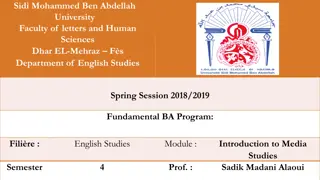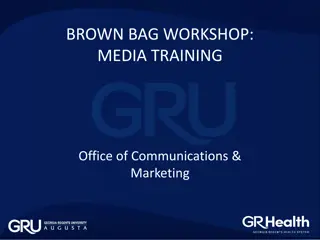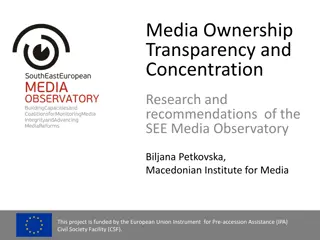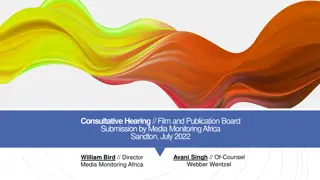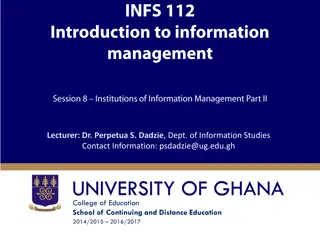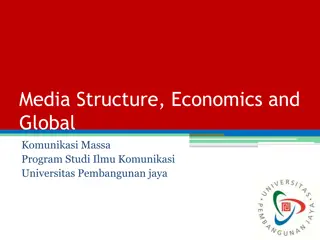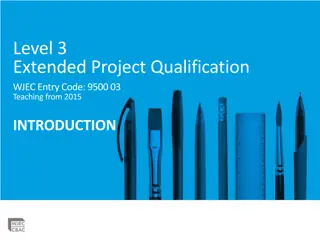
Assessment Criteria and Marking in Media Studies
Discover how assessment in WJEC A-level Media Studies is conducted, including objective marking, academic judgement, and use of subject-specific terminology. Learn about rubric infringements and the assessment purpose in Unit 3: Media in the Global Age.
Download Presentation

Please find below an Image/Link to download the presentation.
The content on the website is provided AS IS for your information and personal use only. It may not be sold, licensed, or shared on other websites without obtaining consent from the author. If you encounter any issues during the download, it is possible that the publisher has removed the file from their server.
You are allowed to download the files provided on this website for personal or commercial use, subject to the condition that they are used lawfully. All files are the property of their respective owners.
The content on the website is provided AS IS for your information and personal use only. It may not be sold, licensed, or shared on other websites without obtaining consent from the author.
E N D
Presentation Transcript
Assessing WJEC A level Media Studies
Assessing evidence Understanding the assessment criteria Marking criteria generally take two forms: objective marking- generally for low tariff responses, where knowledge of objective information is being assessed the exercising of academic judgement via: an assessment grid setting out criteria for different levels of response indicative content, that is, an indication of the kind of content responses may include.
Assessing evidence Understanding the assessment criteria exercising academic judgement through levels of response marking schemes First - identify the appropriate band a learner s response falls into according to the criteria. Award a band where the learner s response covers the majority of the criteria. Second - award a mark in the centre of the band and then increase or decrease the mark depending on the quality of the answer, which may be reflected in the amount of indicative content covered. If a response falls between two bands, consider whether there are more characteristics of the higher or lower of the two bands and award accordingly. Indicative content is not exhaustive and other valid responses may be credited.
Assessing evidence Use of subject terminology Use of appropriate terminology is rewarded within the marking criteria. Unless there is a specific requirement within a question, learners may also be awarded marks where the answer is accurate but expressed in their own words. Use of appropriate subject-specific terminology and accurate grammar, punctuation and spelling should be assessed within each question as part of AO1 (see Unit 3 2019 mark scheme as an example of this).
Assessing evidence Rubric infringements WJEC has a consistent way of addressing rubric infringements across all our qualifications. Below is a list of the possible infringements which sometimes occur for this qualification. Type of infringement Where the correct answer has been clearly crossed out. Action If the learner writes and then crosses out the correct answer, do not award the mark, even if no other answer is offered. Mark all questions that the learner has attempted. Determine which of the attempted routes through the rubric elicits the highest mark. Award highest mark. Answering more than the stipulated number of questions.
Assessing evidence Assessment Purpose Unit 3: Media in the Global Age This unit assesses AO1 and AO2. Learners study a range of contrasting media forms in depth, exploring all of the key concepts media language, representation, media industries, and audiences. The areas studied are: Television in the Global Age Magazines: Mainstream and Alternative Media Media in the Digital Age - Video Games.
Assessing evidence Assessment Criteria Examresponses are assessed using levels of response marking schemes. Qualitative Descriptor Amplification explicit and sustained engagement with specific requirements of question accurate, detailed knowledge and understanding of key concepts perceptive analysis and/or comparison of media products sophisticated use of critical perspectives, including more complex ones studied at A2, examples and references (as appropriate) to support and develop analysis/argument accurate use of appropriate subject specific terminology; accurate grammar, punctuation and spelling Band 5 - Excellent
Assessing evidence Assessment Criteria Examresponses are assessed using levels of response marking schemes. Qualitative Descriptor Amplification clear engagement with question accurate knowledge and understanding of key concepts detailed analysis and/or comparison of media products effective use of critical perspectives, including more complex ones studied at A2, examples and references (as appropriate) to support and develop analysis/argument mostly accurate use of appropriate subject specific terminology; mostly accurate grammar, punctuation and spelling Band 4 - Good
Assessing evidence Assessment Criteria Examresponses are assessed using levels of response marking schemes. Qualitative Descriptor Amplification straightforward engagement with question generally accurate knowledge and understanding of key concepts straightforward analysis and/or comparison of media products straightforward use of critical perspectives, possibly including more complex ones studied at A2, examples and references (as appropriate) in analysis/argument mostly accurate use of appropriate subject specific terminology; mostly accurate grammar, punctuation and spelling Band 3 - Satisfactory
Assessing evidence Assessment Criteria Examresponses are assessed using levels of response marking schemes. Qualitative Descriptor Amplification engagement with question at an obvious, simple level; possible irrelevance and/or lack of development knowledge and understanding of simple/obvious aspects of key concepts simple analysis and/or comparison of obvious aspects of media products; possibly descriptive in parts use of obvious/simple critical perspectives, examples and references (as appropriate) in analysis/argument; possible inaccuracies some errors in use of subject specific terminology, grammar, punctuation and spelling Band 2 - Basic
Assessing evidence Assessment Criteria Examresponses are assessed using levels of response marking schemes. Qualitative Descriptor Amplification limited engagement with question; irrelevance; lack of development limited knowledge and understanding of key concepts limited analysis and/or comparison of media products; descriptive limited, if any, use of critical perspectives; limited examples and references in analysis/argument errors in, or lack of, use of subject specific terminology; frequent errors in grammar, punctuation and spelling Band 1 - Minimal
Assessing evidence Characteristics of a successful response Detailed reference to/perceptive analysis of set products to support arguments Highly effective use of relevant critical perspectives, applied productively and insightfully Explicit and in-depth engagement with the question and debate within it Secure understanding of context and clear linking of aspects of set products to contexts (in context questions) There are examples of successful, higher band responses in the exemplar materials folder on the secure website and the OER materials.
Assessing evidence Characteristics of a less successful response Lack of focus on the specific requirements of the question Use of critical perspectives that are irrelevant/poorly applied/do not meaningfully contribute to the development of analysis/argument Limited understanding of areas of the conceptual framework Simplistic generalisation, description, inaccuracy Describing contexts without making links to set products (in context questions) Lack of focus on set magazine edition, or on front cover only (in Section B)
Additional information Further support and guidance for teachers on the secure website Video tutorial on WJEC Assessment Creation Guide Video tutorial on sharing best practice on centre approach to assessing and awarding qualification grades Video tutorial on ensuring objectivity when assessing learners evidence Information on determining final grades (due after Easter) Timeline for centre determined grades in 2021
Any Questions? If you have any questions, contact our specialist subject officers and administrative support team for your subject with any queries. media@wjec.co.uk






